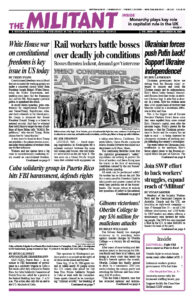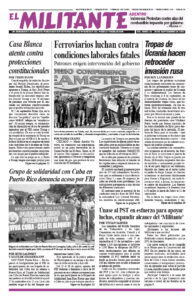Pathfinder Press has released a 60th anniversary printing of October 1962: The ‘Missile’ Crisis as Seen from Cuba. The full story of that moment is told for the first time from the perspective of the Cuban people, whose determination to defend their sovereignty and socialist revolution blocked U.S. plans for a military assault and saved humanity from a nuclear holocaust.
Pathfinder and the Socialist Workers Party are planning efforts to promote the book this fall. An excerpt is featured in this week’s Books of the Month article.
The author, Tomás Diez Acosta, 16 years old at the time, participated in the mobilization of Cuba’s Revolutionary Armed Forces in October 1962. He had been one of the 300,000 young Cubans who mobilized across the country to teach every Cuban how to read and write. When he retired from active military service 37 years later, Diez held the rank of lieutenant colonel.
The immediate roots of the October crisis, Diez explained, were found in the actions undertaken by the U.S. government after its defeat at the Bay of Pigs in April 1961, where Cuba’s revolutionary militias and armed forces crushed a U.S.-organized mercenary invasion of 1,500 in less than 72 hours.
Drawing on declassified White House, CIA and Pentagon files, Diez exposes the extent of the U.S. government’s attempts to overthrow Cuba’s socialist revolution. Much of this material is made available for the first time.
In May 1961 the CIA launched “Operation Patty,” trying to put in place plans to assassinate Fidel and Raúl Castro at upcoming July 26 celebrations marking the anniversary of beginning of the Cuban Revolution. Then in November 1961 President John Kennedy authorized the development of Operation Mongoose, a wide range of planned disruptions in Cuba, which Diez documents.
Attorney General Robert Kennedy said at the time that solving the “Cuban problem” was “the top priority in the United States Government — all else is secondary — no time, money, effort, or manpower is to be spared.”
These attacks set the framework for Cuba’s acceptance of a Soviet proposal for a defense pact between Cuba and the Soviet Union in July 1962 that included deployment of Soviet missiles in Cuba, along with a contingent of some 42,000 Soviet troops.
Moscow hoped this would provide a bargaining chip to counter Washington’s placement in Turkey and Italy of Jupiter missiles aimed at Russia.
In his chapter “The Secret and the Deception,” Diez describes the disagreements between the Soviet and Cuban leaderships over Moscow’s insistence on keeping these moves secret. From the beginning, the Cuban leadership argued for announcing the pact, insisting on the right of the Cuban people to defend themselves.
When U.S. spy planes discovered the missile sites under construction, Washington imposed a naval blockade on Cuba, stepped up preparations for an armed assault, and put its troops on nuclear alert. Moscow’s response was to order the missiles removed without consulting Cuba.
Cuba’s working people stood ready to defend their revolution with determination and courage. On Oct. 26, at a decisive moment in the unfolding crisis, President Kennedy asked the Pentagon for an estimate of what casualties U.S. forces would suffer if they invaded Cuba. The Pentagon said to expect 18,500 casualties in the first 10 days. This was more than Washington suffered in the first five years of fighting in Vietnam!
“To their positions of force, we shall respond with our firmness. To their attempt to humiliate us, we shall respond with our dignity. To their aggression, we shall respond with our determination to fight to the last combatant,” Osvaldo Dorticós, president of Cuba, and Prime Minister Fidel Castro explained that November.
The U.S. government backed down.
The book is invaluable for what it tells you about the moral and political character of Cuba’s revolutionary workers and farmers.

